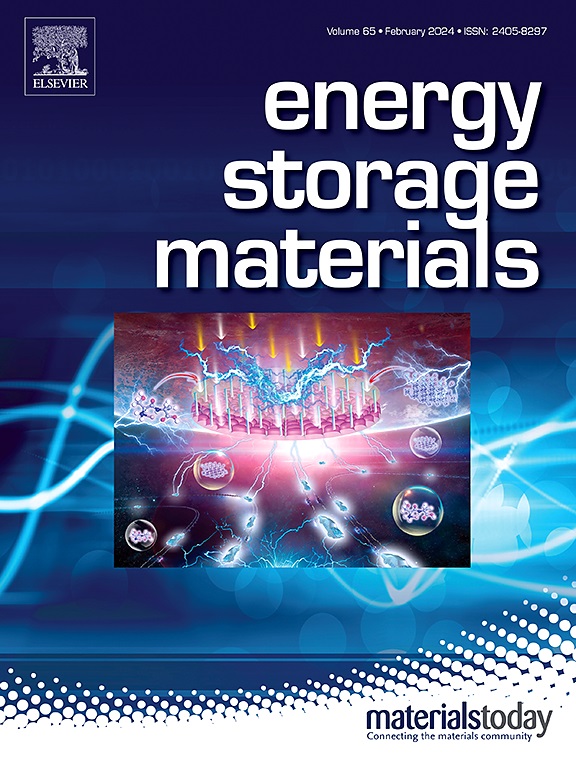Fine-tuning for rapid capacity estimation of lithium-ion batteries
IF 20.2
1区 材料科学
Q1 CHEMISTRY, PHYSICAL
引用次数: 0
Abstract
The widespread adoption of large-scale battery-powered technologies, such as electric vehicles and renewable energy storage systems, has led to growing interest in assessing their remaining usability after years of operation. As these systems age, state-of-health estimation becomes crucial for ensuring reliability and safety, and for extending life through second-use applications. However, current methods — spanning physics-based, empirical, and data-driven approaches — face challenges, including insufficient labeled data, high resource costs, and poor generalizability across diverse usage conditions. Data-driven models, in particular, struggle to extrapolate beyond their training domain, limiting their applicability in real-world scenarios. This work develops a fine-tuning framework to address these challenges, enabling rapid capacity estimation using short-duration ( s) features. Tested on two battery chemistries (LFP/Gr and NMC/Gr), the fine-tuned model achieves average mean-absolute-percent-errors of 2.592% and 3.094% on datasets collected from the respective chemistries. Compared to two baseline approaches, direct-transfer and target-only modeling, fine-tuning achieves a 25% reduction in estimation error in the target domain, on average. Domain differences are quantified using statistical measures such as Kullback–Leibler divergence and maximum mean discrepancy. These measures are found to correlate with fine-tuning performance, offering insights into domain compatibility. This study also analyzes the impact of feature selection, hyper-parameter tuning, and labeled data availability on fine-tuning efficacy, providing practical guidelines for real-world applications.


锂离子电池容量快速估算的微调
随着电动汽车和可再生能源存储系统等大规模电池供电技术的广泛采用,人们对评估其运行多年后的剩余可用性越来越感兴趣。随着这些系统的老化,健康状态评估对于确保可靠性和安全性以及通过二次使用延长寿命变得至关重要。然而,目前的方法——包括基于物理的、经验的和数据驱动的方法——面临着挑战,包括标记数据不足、资源成本高、在不同使用条件下的泛化性差。特别是数据驱动的模型,很难推断出它们的训练领域之外,限制了它们在现实场景中的适用性。这项工作开发了一个微调框架来解决这些挑战,实现了使用短持续时间(≤100秒)特征的快速容量估计。在两种电池化学物质(LFP/Gr和NMC/Gr)上进行测试,微调模型在各自化学物质收集的数据集上的平均绝对百分比误差分别为2.592%和3.094%。与两种基线方法(直接转移和仅目标建模)相比,微调平均可将目标域的估计误差降低25%。利用Kullback-Leibler散度和最大平均差异等统计度量对域差异进行量化。这些度量被发现与微调性能相关,提供了对域兼容性的洞察。本研究还分析了特征选择、超参数调优和标记数据可用性对微调效果的影响,为实际应用提供了实用指南。
本文章由计算机程序翻译,如有差异,请以英文原文为准。
求助全文
约1分钟内获得全文
求助全文
来源期刊

Energy Storage Materials
Materials Science-General Materials Science
CiteScore
33.00
自引率
5.90%
发文量
652
审稿时长
27 days
期刊介绍:
Energy Storage Materials is a global interdisciplinary journal dedicated to sharing scientific and technological advancements in materials and devices for advanced energy storage and related energy conversion, such as in metal-O2 batteries. The journal features comprehensive research articles, including full papers and short communications, as well as authoritative feature articles and reviews by leading experts in the field.
Energy Storage Materials covers a wide range of topics, including the synthesis, fabrication, structure, properties, performance, and technological applications of energy storage materials. Additionally, the journal explores strategies, policies, and developments in the field of energy storage materials and devices for sustainable energy.
Published papers are selected based on their scientific and technological significance, their ability to provide valuable new knowledge, and their relevance to the international research community.
 求助内容:
求助内容: 应助结果提醒方式:
应助结果提醒方式:


